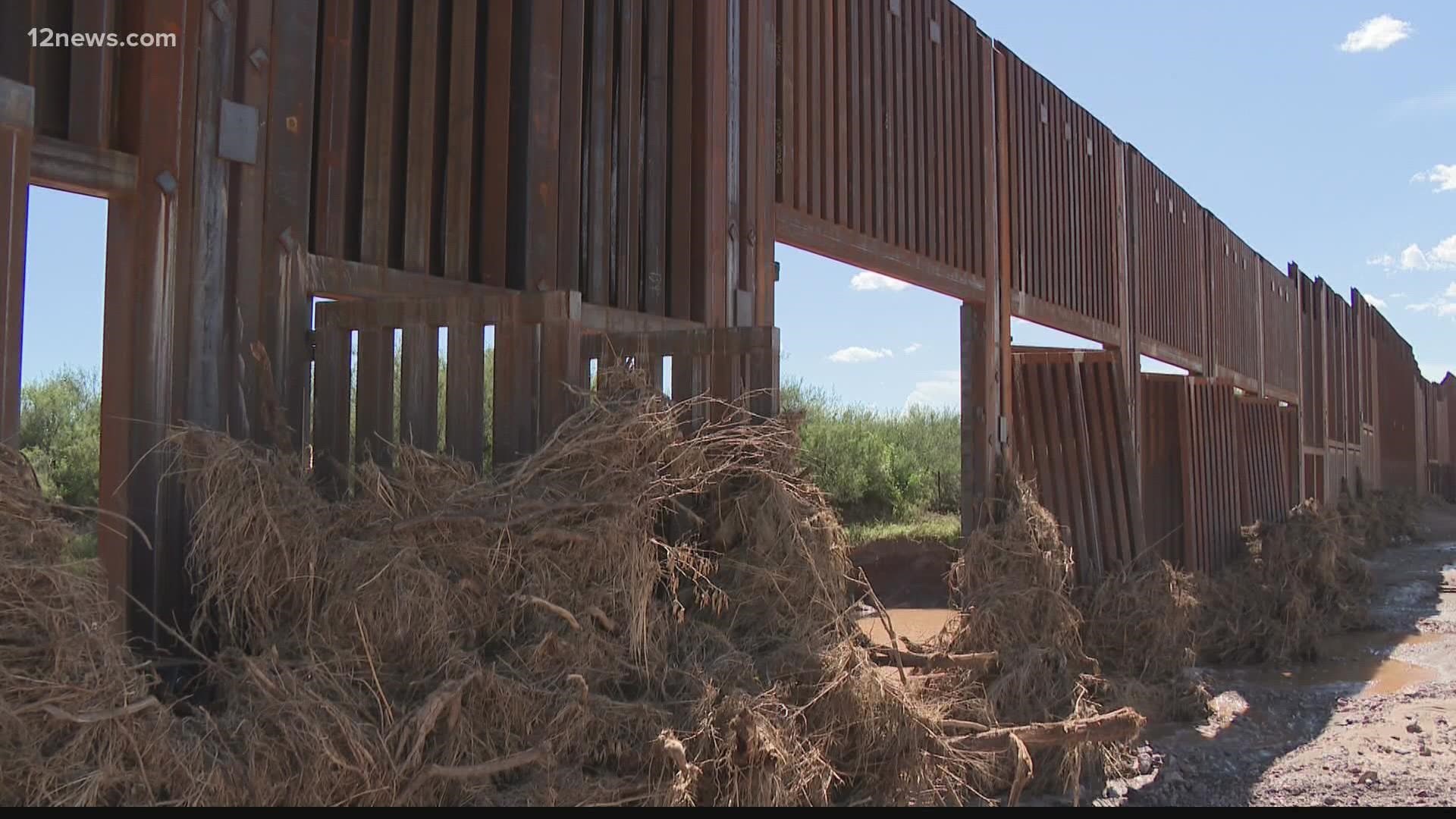DOUGLAS, Ariz. — Nine border wall gates were ripped off their steel hinges by flooding from monsoon rains just months after the section of the structure was completed near Douglas.
The powerful waters twisted metal and displaced five of the gates that were installed in the Silver Creek water bed in Cochise County. Other gates were left buried in mud and on the Mexico side of the wall.
Silver Creek is about 15 miles east of Douglas, Arizona and two miles west of the San Bernardino National Wildlife Refuge. Flash flood events occur several times a year in the area.
During the first monsoon event, rain did not fall at the site, but rather upstream, out of sight, making it difficult to predict when the creek will get floodwaters, said Myles Traphagen, Borderlands Program Coordinator for the non-profit, Wildlands Network.
“If we would have had this type of rainfall last year, I think things would have gone a little bit differently, they would have thought this out a little bit more, maybe they would have realized that you’re not going to be able to wall-off the entire U.S.-Mexico border, it’s just not feasible,” he said.
The Trump Administration built more than 450 miles of fencing along the U.S.-Mexico border, this largely included replacing previous barriers. Only 52 miles of construction involved fencing where there was none before, including washes and river beds, like in Silver Creek.
To build the 30-foot structure, the federal government waived more than 50 environmental laws, including the endangered Species Act, Clean Water Act, Clean Air Act and NEPA.
Traphagen said for projects of this magnitude, in high-energy environments, it usually takes countless studies to figure out the hydrologic conditions that are likely to be encountered in the years following its completion. But he alleges the project was rushed and no such measures took place.
“They did not anticipate this, that this was going to happen,” Traphagen said. “Maybe they did and just didn’t care. But I’m not very optimistic about how long this structure is going to last.”
The massive event left flood debris literally embedded into the border walls. The volume of water that passed through the gates rose 20 feet above Silver Creek's bank, and the water stretched about three football fields.
“This is just the first year that the wall’s been up, so we will see this every year,” said Laiken Jordahl, a borderlands campaigner for the Center for Biological Diversity.
Jordahl said his organization, along with federal land managers, private property owners and credentialed scientist sent an opposing letter predicting the steel wall would be damaged at creeks and rivers where the soil is consistently in motion
“It feels like an ‘I told you’ moment. But on the other hand, it’s enraging, because they are billions of tax dollars that have gone into this project that are being wasted and now every single year, we’re going to spend billions more repairing, maintaining, rebuilding the structure,” Jordahl said.
Areas where the border wall was newly installed and replaced are already experiencing saturated conditions, Traphagen said. He is a biologist that monitors border wildlife over time.
In July 2020, Traphagen surveyed the area during a flooding event before the wall was completed. At the time, Normandy barriers were placed in river washes and beds to serve as vehicle deterrents. Limited rain that day, was strong enough to wash away barriers.
After surveying areas along Sasabe and Douglas, Traphagen said the saturated conditions are already happening where the new fence was built. Meaning continuous rain could pose a threat to the structure.
“Eventually nature is going to win, it’s going to figure out a way to get around this [wall],” he said.
In a statement, the Army Corps of Engineers in charge of the cleanup along the border wall said they and CBP are assessing the damage, but provided no timeline of when the barriers would be repair.
In August, an Arizona federal judge ruled the Department of Homeland Security and Border Protection failed to study potential harms to the environment from increased enforcement along the U.S. Mexico border.
“Every day this wall is up, more wildlife will die and suffer,” Jordahl said.
His organization and other local groups have documented animals trying to get across the wall during their migration cycles in search of food and water, but some have turned up dead along the structure.
“It’s just an evitable outcome that [we’re] going to see catastrophic events like these, and this is just the first one of the season,” Traphagen said.
12 News on YouTube
Arizona has seen its fair share of severe weather. Here is a compilation of videos from coverage of various storms and other weather trends across the Grand Canyon state.

